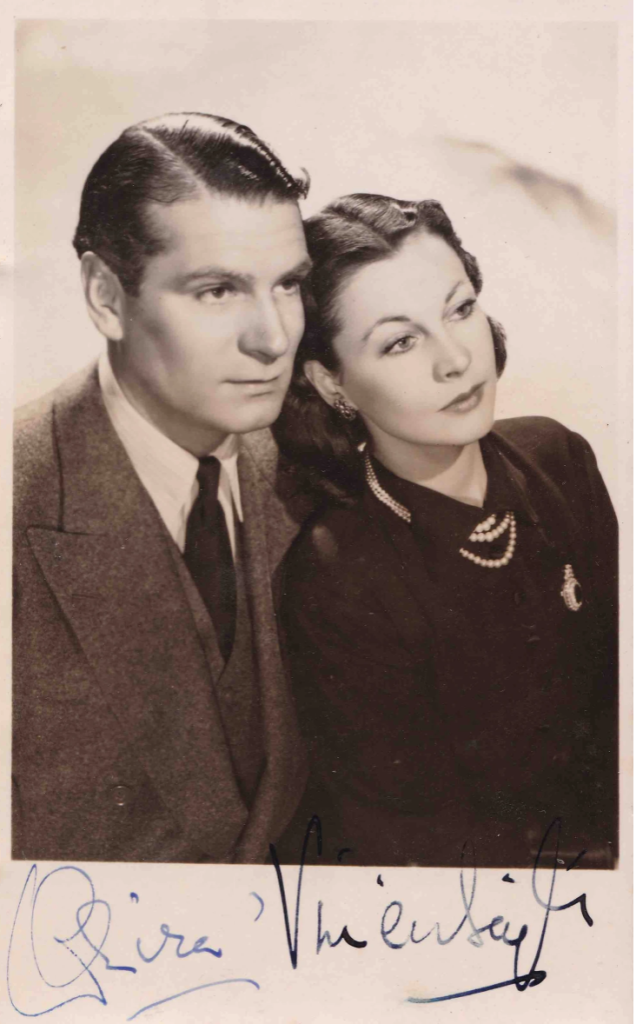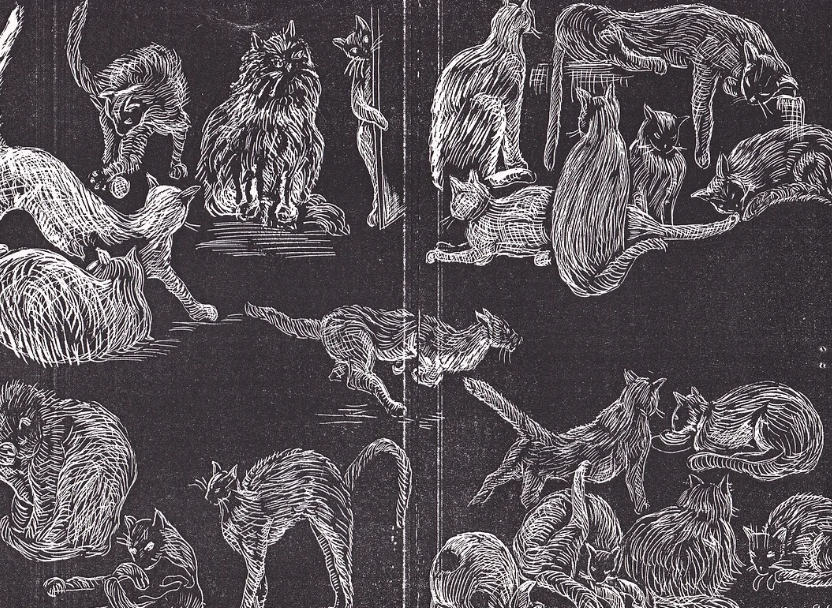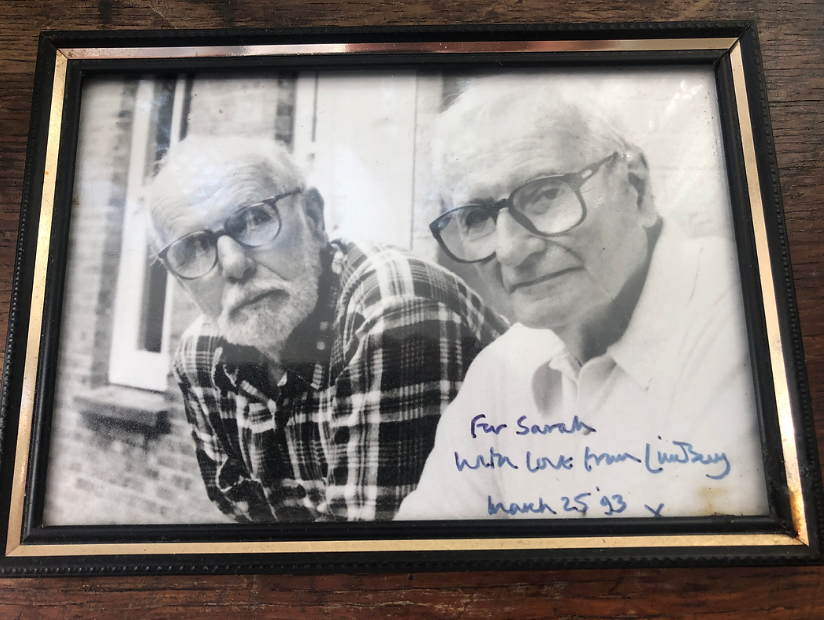Sarah Bloomfield, an important character in the Everyman story: Charles Drazin
Posted January 2025
This blogpost by Charles Drazin, film historian, author and editor, is about his friend Sarah Bloomfield who worked as an usherette at the Everyman from 1958 until the early 1980s. A talented artist, she was very much part of bohemian cultured Hampstead where her intellectual parents presided over ‘an extraordinary salon of writers, artists musicians, waif and strays’ at their book-filled home in Thurlow Place. Despite being severely deaf, Sarah was a much valued colleague and member of the Everyman community. See https://www.charlesdrazin.com/post/larry-vivien-and-sarah
There’s a story behind every picture, but often it can take you to a place very different from where you might have imagined. This picture belonged to a friend, Sarah Bloomfield, who died during the Pandemic. It must have been taken – and signed – at some point in the late 1940s.

The London West End stage production of A Streetcar Named Desire opened at the Aldwych Theatre on 11 October 1949. Its director, Laurence Olivier, and star, Vivien Leigh, were at the height of their fame as the world’s golden couple. Vivien Leigh would go on to appear in the Hollywood film of the play, for which she won an Oscar to add to the one she already had for Gone with the Wind, while Olivier, that year alone, won two Oscars for acting in and producing his film version of Hamlet. This kind of success meant that they no longer even had to be awake to be the centre of attention. Their mere existence guaranteed the launch of a thousand flash bulbs.
The age of rock ’n’ roll was soon to dawn, which would take fan worship to a whole new level, but even in 1949 a sizeable crowd could be guaranteed to be waiting for the Oliviers at stage doors around the world.
Among them – at least as far as the London stage doors were concerned – was Sarah Bloomfield, who was then sixteen years old. Soon after seeing A Streetcar Named Desire at the Aldwych, she asked a family friend, Lindsay Anderson, who then ran a small film magazine called Sequence, if he could get her some pictures of Olivier. With his usual generosity, he did so.
Passionately devoted to film and theatre, Sarah was a talented artist who went on to study at St Martin’s School of Art. Her ambition was to become a costume designer in opera. It would have been a tall order even had she not been severely deaf. She worked instead as an usherette at the Everyman Cinema in Hampstead, North London, but still continued to pursue her passion for costume design in her spare time. The Everyman were so proud and encouraging of her that in 1970 they put on an exhibition of her designs in their foyer.

But then the 1980s happened. A new manager took over, and Sarah, now fifty years old, did not fit into his plans for turning the cinema into a cool, happening place that would attract a younger audience. He dismissed her on the grounds that her deafness was a safety risk.
A remarkably resilient person – who all her life had faced that terrible irony of the deaf of having to fight to be heard – she took the Everyman to an industrial tribunal, which ruled in her favour. Her hearing had been adequate enough for her to do her job for the first 23 years of her service, concluded the tribunal, and there was no evidence that it had deteriorated.
Present at the tribunal to argue Sarah’s case was her old friend Lindsay Anderson, who, thirty years on, was now one of Britain’s best-known film and theatre directors. By chance one of his early films to win recognition – only a few years after he had managed to get hold of the Olivier pictures for Sarah – was Thursday’s Children, which was about a school for the deaf. It was a deeply moving film that in 1955 won an Oscar for best short documentary. “They will find,” commented the narrator Richard Burton (who would later become part of a 1960s golden couple which rivalled even the Oliviers), “that the world outside is often in a hurry, and luckier people, who have hearing, are often impatient with those who have none none, but these children will not be unprepared. There is a spirit in them which will make up for some of the good things they’ve got to miss.”
In her battle with the Everyman – a place she had loved so much that she had been writing a book on its history – Sarah showed that spirit. Her compensation for winning the case was small, but it was the principle that mattered. She told her local newspaper, the Ham and High, that she thought discrimination against deaf people was much higher than the figures suggested because so often people failed to seek help. “They are too frightened to go to the Citizens Advice Bureau, so they get stuck with the shame of the situation. I hope in the future I will be able … to persuade people that if they are discriminated against it means an awful lot to them and their families if they can be persuaded they are just as normal as everybody else. And if an industrial tribunal can help them to feel that, it is all for the better.”
Sarah did not manage to get another job, but she continued to make art. It was a great pleasure for her friends every Christmas to receive her latest lino-cut card. One of my favourites is this one of about twenty cats she had got to know over the years (which I see from the date she must have carved just before the Everyman dismissed her).

After Sarah’s death I helped to go through the papers in her flat. An extraordinary Aladdin’s cave of treasures included her album of 1940s stars, with all the pictures of the Oliviers, along with several Old Vic Theatre Company programmes. It included, too, the research notes for the book she had been writing on the Everyman cinema when she was dismissed, and, perhaps most poignantly, a copy of a long letter that she had written some time afterwards to the Royal National Institute for the Deaf, which had financed her case at the industrial tribunal. It described how she had been coping since her dismissal.
“As to the effects of these years, well nothing but devastation … unutterable, black, deep depression.” Losing her job had “destroyed” her life, she wrote, “but I try not to be bitter because it is futile to be so”. Although she had suffered terribly from the world’s impatience, which dented her self-belief and thwarted her creative nature, she was blessed with a sunny, loving personality and a warmth that underpinned the several long friendships that helped to sustain her.
A touching discovery among her papers was a memoir she had written of Lindsay Anderson, whom she described as “the greatest support in the unexpected nightmares of life. Whatever, he was there. Comforter, sorter-out, friend, as he had been since I was a child.” And on a mantelpiece, there was a photograph that Lindsay had sent of himself and his older brother, Murray, on the occasion of Sarah’s sixtieth birthday. His death the following year must have been another huge blow, but somehow she managed to weather it.

Sarah’s story has taken me a long way from where I began with a picture of Larry and Vivien, but I don’t think it is difficult to find a connection. Certainly all those Old Vic plays must have provided a good lesson in how to cope with adversity – Oedipus Rex, Antigone, King Lear! When the teenage Sarah went to the New Theatre in St Martin’s Lane to see Olivier as the old king in 1946, she could not possibly have imagined the personal resonance that the play would one day have. “No, I’ll not weep: / I have full cause of weeping, but this heart / Shall break into a hundred thousand flaws / Or e’er I’ll weep.”
When she had opened up her heart in that letter to the RNID, her main purpose in writing was to express her eagerness to help the charity “to draw attention to the brilliance of deaf people”, and she would go on to contribute lino-cut drawings to the RNID’s magazine, Soundbarrier.
Unlike Larry and Vivien, the world’s photographers would take no interest in Sarah, but how she had moved on from her own career in the cinema was certainly a good example of the brilliance she had shown as a caring, compassionate human being.